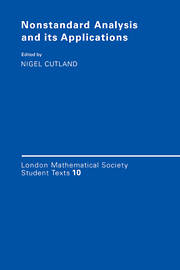Book contents
- Frontmatter
- Contents
- Preface
- Contributors
- AN INVITATION TO NONSTANDARD ANALYSIS
- INFINITESIMALS IN PROBABILITY THEORY
- INFINITESIMALS IN FUNCTIONAL ANALYSIS
- APPLICATIONS OF NONSTANDARD ANALYSIS IN MATHEMATICAL PHYSICS
- A LATTICE FORMULATION OF REAL AND VECTOR VALUED INTEGRALS
- AN APPLICATION OF NONSTANDARD METHODS TO COMPUTATIONAL GROUP THEORY
- SYNTACTICAL METHODS IN INFINITESIMAL ANALYSIS
- SOME ASYMPTOTIC RESULTS IN ORDINARY DIFFERENTIAL EQUATIONS
- SUPERINFINITESINALS AND INDUCTIVE LIMITS
- THE NON-LINEAR BOLTZMANN EQUATION FAR FROM EQUILIBRIUM
- INDEX
APPLICATIONS OF NONSTANDARD ANALYSIS IN MATHEMATICAL PHYSICS
Published online by Cambridge University Press: 05 June 2012
- Frontmatter
- Contents
- Preface
- Contributors
- AN INVITATION TO NONSTANDARD ANALYSIS
- INFINITESIMALS IN PROBABILITY THEORY
- INFINITESIMALS IN FUNCTIONAL ANALYSIS
- APPLICATIONS OF NONSTANDARD ANALYSIS IN MATHEMATICAL PHYSICS
- A LATTICE FORMULATION OF REAL AND VECTOR VALUED INTEGRALS
- AN APPLICATION OF NONSTANDARD METHODS TO COMPUTATIONAL GROUP THEORY
- SYNTACTICAL METHODS IN INFINITESIMAL ANALYSIS
- SOME ASYMPTOTIC RESULTS IN ORDINARY DIFFERENTIAL EQUATIONS
- SUPERINFINITESINALS AND INDUCTIVE LIMITS
- THE NON-LINEAR BOLTZMANN EQUATION FAR FROM EQUILIBRIUM
- INDEX
Summary
Abstract. The aim of this article is to give a short introduction to applications of nonstandard analysis in mathematical physics. Two basic techniques, the hyperfinite and the hypercontinuous are presented, together with illustrations mainly from quantum mechanics, polymer physics and quantum field theory.
INTRODUCTION
Nonstandard analysis is a specific mathematical technique as well as a way of thinking: both aspects are also represented in the interaction between nonstandard analysis and mathematical physics, which is the subject of this paper. As in other domains of application of nonstandard analysis, mathematical physics (or the mathematical study of problems of physics) has particular aspects that make some of the nonstandard methods most natural to use. Often in mathematical physics one has to study systems with many interacting components, idealized as systems with infinitely many degrees of freedom. To look upon a fluid or a gas as a composed of infinitely many particles might seem at first sight to be a very rough abstraction, but is a useful one for mathematical purposes, being in some sense easier to handle than the more realistic case of finitely many particles. On the other hand, in quantum field theory, for example, the abstraction itself creates its own problems, like the famous ones connected with divergences, about which we will say a few more words below; sometimes also it is only in a limit, like that of infinitely many degrees of freedom, that one “sees” some specific phenomenon, raising challenging problems, like phase transitions in thermodynamic systems (only perceived in the so called ”infinite volume“ or “thermodynamic limit”),or exact invariance properties (under a continuous group of symmetries), in systems idealized as “continua” (as in field theories).
- Type
- Chapter
- Information
- Nonstandard Analysis and its Applications , pp. 182 - 220Publisher: Cambridge University PressPrint publication year: 1988
- 9
- Cited by



